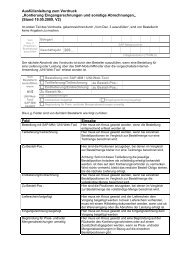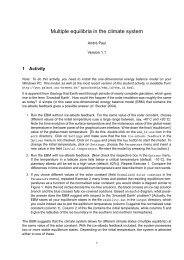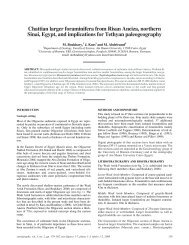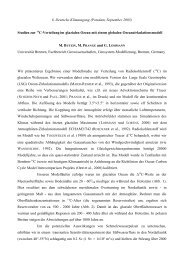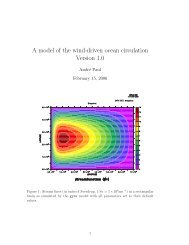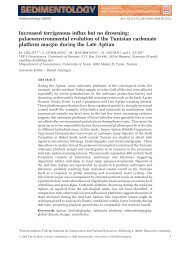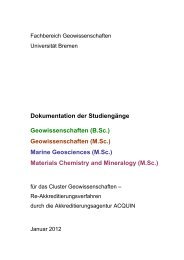30Tailoring the electronic properties of TiO 2Defect engineering in TiO 2 – from bulk to nanostructuresP. Deák, B. Aradi, Bremen Center for ComputationalMaterials Science, University BremenAbstract• TiO 2 is a versatile material which is already usedin many applications.• In order to achieve better performance and to extendthe spectrum of applications, the electronicproperties of bulk and nanostructured TiO 2 haveto be investigated.• Defects have a significant effect on the electronicproperties, therefore, they must be includedwhen such properties are investigated.• TiO 2 is a very challenging material for electronicstructure calculations, making the application ofnew methods necessary.TiO 2 is a wide band gap crystalline oxide with manyexisting and potential applications, from the pigmentindustry and photocatalytic air- and waterpurification, through water splitting and hydrogenstorage, high-k dielectric and room-temperatureferromagnetic semiconductors, to electron transmittersin electrochemical solar cells, and transparentconductive oxides in optoelectronics. In mostof these applications the understanding of chargecarrier generation and recombination is of crucial<strong>im</strong>portance. Such phenomena are governed byintrinsic defects, <strong>im</strong>purities and dopants. Our researchstrategy is to establish first a knowledgebase about defects and their interactions in bulkmaterials, by means of high-level quantum mechanicalcomputations. Once that is achieved, wewill analyze the behavior of defects in the presenceof surfaces and in nanostructured material. Thetask is made difficult by the fact that the “standardtool” of defect calculations – (semi)local approx<strong>im</strong>ationsof density functional theory (DFT) – failsfor defects in most wide band gap metal oxides.We have chosen to go beyond the standard approx<strong>im</strong>ationsby testing the screened hybrid functionalHSE06. Although this is essentially a semiempiricalapprox<strong>im</strong>ation, we have shown that fordefects of traditional group-IV semiconductors thetotal energy computed with this functional showsthe correct linear dependence on the (fractional)occupation number of the defect level. As a consequenceof that, the ionization energy of a defectis accurately given by the Kohn-Sham-energyof the defect level, in unprecedented agreementwith exper<strong>im</strong>ent [1], [2], [3]. Based on these results,we have investigated the performance of theHSE06 functional for TiO 2 . The electronic structureis in excellent agreement with the result obtainedfrom ab initio many-body perturbation theory(GW method) and from photoelectron spectroscopy(PES). As a next step, we have demonstratedthe equality between the Kohn-Sham energylevel and the ionization energy of defects inboth the anatase and rutile modifications of TiO 2 .This is of special <strong>im</strong>portance, because these twomodifications show strong and different polaroniceffects. In rutile, mobile electrons tend to be selftrappedby a local change in the chemical stateof a Ti atom (from 4+ to 3+), while in anatase, as<strong>im</strong>ilar local change of an O atom (from 2- to 1-) traps mobile holes. Standard approx<strong>im</strong>ations ofDFT fail to describe these effects. Our calculationswith HSE06 have found, in agreement with exper<strong>im</strong>ent,that n-type doping in rutile and p-type dopingin anatase are counteracted by these self-trappingeffects. These results prove that the HSE06 functionalcan supply very accurate electronic structureresults in TiO 2 based systems.Therefore, we have used the method to calculatethe generic band off-sets between bulk rutileand anatase, which have great significance forphotochemical applications, where a mixed phaserutile-anatase system is used. We have foundthat the band alignment leads to bipolar carrierseparation: electrons should be accumulated inanatase, and holes in rutile. We have also investigatedthe optical effective mass of electrons (averagemass of the conducting electrons) in highlyNb-doped anatase, which can be used as a transparentconductive oxide. The HSE06 electronicstructure gives an excellent description of the observations.Our prel<strong>im</strong>inary investigations on Tadopingindicates that is is more favorable than Nbdoping,as far as the anisotropy of the effectivemass is concerned. We have also investigated thepossibility of p-type doping in anatase. We havefound that, due to hole localization, the acceptorsare all rather deep and the calculated formationenergies are much too high for practical purposes.It should be taken into account, though, thatdonors (like the oxygen vacancy or hydrogen interstitials),incorporated s<strong>im</strong>ultaneously with the acceptors,d<strong>im</strong>inish the heat of solution considerablyby charge compensation, and so, in fact, very highconcentration of the acceptors can be achieved.(A non-equilibrium concentration of activated acceptorscan then be obtained by annealing in dryair and quenching.) Another possibility is dopingChemie
31Figure 1: Model for a subnanometer-sized anatase wire.by complexes which cause much smaller latticestrain than isolated acceptors. The investigation ofsuch phenomena will be carried out in the presentproject year. We intend to conclude our studies onbulk defects by investigating the very controversialissue of the intrinsic defects (oxygen vacancy andtitanium self-interstitial). These defects are of crucial<strong>im</strong>portance in explaining the room temperatureferromagnetism observed in thin anatase films.In the last phase of our investigations on TiO 2 ,we will concentrate on low-d<strong>im</strong>ensional systems,besides thin films mainly on nanowires. In structureswith lower d<strong>im</strong>ensionality, the large surfaceto volume ratio will change the energetic relationsbetween dopants and intrinsic defects, andnanostructures can be expected to be more flexiblein accommodating volume changes. Recentexper<strong>im</strong>ental work has shown the existence of extremelythin anatase nanowires, and their capabilityto incorporate an unusually high amount of nitrogen.Our s<strong>im</strong>ulation of the HRTEM (high resolutiontransmission electron microscopy) picturesshow that the wire structure which was proposedby the exper<strong>im</strong>entalists to explain their data, is notcorrect. Based on some prel<strong>im</strong>inary calculations,we suggest another model, which is more in accordancewith the observed HRTEM picture. Usingour new models, we will investigate the nitrogenuptake and the effect of surface functionalizationon the electronic structure of anatase nanowires.Finally, we intend to use our results to establish aresearch direction into phase changes induced bydefect aggregation in TiO 2 . Such phenomena areat the heart of TiO 2 based memristors, to be usedfor high density storage with resistance switching(RRAM).More Information1. P. Deák, B. Aradi, T. Frauenhe<strong>im</strong>, E. Janzén,and A. Gali, Phys. Rev. B 81, 153203 (2010).2. P. Deák, A. Gali, B. Aradi, and T. Frauenhe<strong>im</strong>,in Advanced calculations for defects inmaterials, eds. A. Al-kauskas, P. Deák, J.Neugebauer, A. Pasquarello, and C. G. Van deWalle [Wiley-VCH, Berlin <strong>2011</strong>] online at DOI:10.1002/pssb.2010462103. A. Gali, E. Janzén, P. Deák, G. Kresse, and E.Kaxiras, Phys. Rev. Lett. 103, 186404 (2009)FundingUniversity BremenChemie



